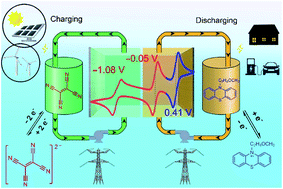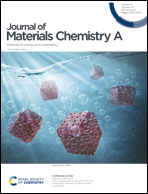Two-electron-active tetracyanoethylene for nonaqueous redox flow batteries†
Abstract
Redox flow batteries (RFBs) are regarded as one of the most promising energy storage devices for the efficient utilization of intermittent renewable energy, such as solar and wind energies, yet the development of RFBs has been hindered by the narrow electrochemical window of aqueous electrolytes. Developing nonaqueous RFBs using organic electrolytes is an attractive way to address the abovementioned issue. Here, we report a cyanocarbon-based, two-electron-active anolyte compound, tetracyanoethylene (TCNE), with high solubility (2.0 M in acetonitrile), remarkable electrochemical stability and redox reversibility, and fast electrokinetics. Density-functional theory (DFT) calculations for different oxidation states of TCNE were performed to evaluate molecular orbitals during redox processes. Inexpensive and environmentally friendly sodium perchlorate is used as the supporting electrolyte as a replacement for the more commonly used and expensive tetraalkylammonium salts. When paired with a phenazine derivative (PEG1-PTZ) catholyte, the all-organic nonaqueous RFB exhibits a cell voltage of 1.45 V, a capacity retention of 73.3% over 200 cycles (99.9% per cycle), and a maximum power density of 72.5 mW cm−2. This study introduces a new type of redox-active organic compound with multi-electron activity, high electrochemical reversibility, and desirable electrokinetics, enriching the family of organic compounds for nonaqueous RFBs.



 Please wait while we load your content...
Please wait while we load your content...